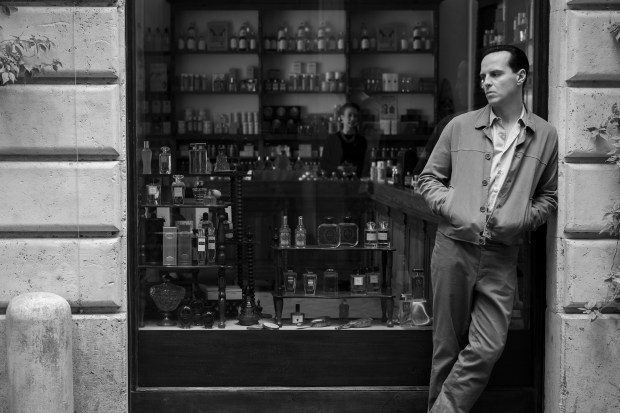The character of Tom Ripley, luxury connoisseur and con man extraordinaire, appeared in five Patricia Highsmith novels, beginning in 1955 with “The Talented Mr. Ripley.” The book is his origin story, of a young grifter who encounters wealth and status up close and begins to envision a different life for himself. Unfortunately for those in his orbit, Tom’s methods include identity theft and a few murders. In Anthony Minghella’s 1999 movie starring Matt Damon, Jude Law and Gwyneth Paltrow, this plays out as a vibrant explosion of Tom’s desires, which are just as dangerous when fulfilled as when thwarted. Any remake needs to bring something new, or at least different, to the screen, and that’s true enough of the eight-episode Netflix series “Ripley” starring Andrew Scott. Whether it succeeds in capturing the essence of Tom Ripley is another question.
It’s impossible not to compare the two adaptations, which have distinct tonal approaches. The former offers a sumptuous version of expat extravagance, vibrant and lustful. The latter is cooler to the touch. Shot in black and white, it’s literally seeped of color, but visually it is as gorgeous as anything you’ll find on television at the moment.
The story begins like this: A shipping magnet in New York mistakes Tom for a friend of his ne’er-do-well son, Dickie Greenleaf, who has been living off his trust fund in a coastal village in southern Italy. But Papa has decided enough is enough, it’s time for him to take his place in the family business. So he sends Tom overseas to convince Dickie that his future is behind a desk in New York. This trip to Italy is the door through which Tom will enter a different world, of casual glamor and monied leisure, and suddenly his longings snap into focus.
Dickie spends languorous days with his girlfriend, Marge, and he represents everything Tom covets. In Minghella’s film, he is swaggering and tanned and charismatic. It was Law’s breakout role, exuding so much heat and sex that he becomes the object of Tom’s ravenous cravings — not just for the conspicuous status markers but for Dickie himself. The story’s homoerotic subtext becomes text.
The Netflix series comes from Steven Zaillian, an accomplished screenwriter whose credits include everything from “The Irishman” to “Schindler’s List,” and his choices are less primal and more intellectual than Minghella’s.
You always feel like you’re in good hands with an actor like Andrew Scott and he gives a layered performance that finds all kinds of interesting — sometimes compellingly unsuccessful — bluffs meant to hide Tom’s insecurities. He’s utterly captivating as a man with sociopathic tendencies and his own personal (if tremendously cracked) moral code, but for one glaring issue. In the original novel, Ripley is 25. Scott is two decades older than that. Are we meant to suspend our disbelief, or is Dickie (played by John Patrick Vivian Flynn, also long past his 20s) supposed to be middle-aged as well? If so, that changes the story’s context in subtle ways that go unaddressed by the script.
This version also paints Tom as an asexual creature, which undercuts much of the potential frisson. Dickie’s world is meant to be such an incredible turn-on that Dickie himself is a turn-on. But the character is little more than a blank. The same goes for Marge, played by Dakota Fanning.
What the series lacks in carnal energy, it makes up for with an indelible visual language courtesy of director of photography Robert Elswit. The cinematography is plainly stunning and it’s one of the real pleasures of each episode, specifically the way moments are framed. A crisp white business card against the worn grain wood of a bar top. Winding stairways that alternately suggest a yawning void — or a trap. A fluffy cat staring at Tom as he drags a dead body. Any moment could be a still image you would hang as a work of art. The floors are marble and travertine and tile, which accentuate the echo of footsteps, becoming a delectable soundtrack underscoring the cat-and-mouse of it all, once the Italian police get involved.

The eight-episode running time means Zaillian has room to contemplate the logistics of violence. Tom favors blunt-force trauma to the head, with the help of a boat oar or a heavy glass ashtray. But it is the immediate aftermath that Zaillian wants to ponder. These wordless scenes are long and riveting and some of the best moments of the series, watching as Tom figures out his next moves and how to get rid of the evidence, including the corpse itself. It’s an aspect most crime dramas gloss over, but the attention to detail is thrilling. With Tom, the adrenaline-fueled violence isn’t premeditated, but it’s always followed by careful, semi-frantic, semi-numb attempts to save his own hide. Zaillian wants you to see what that looks like in real-time, and he is unflinching.
“Ripley” — 2.5 stars (out of 4)
Where to watch: Netflix
Nina Metz is a Tribune critic.



